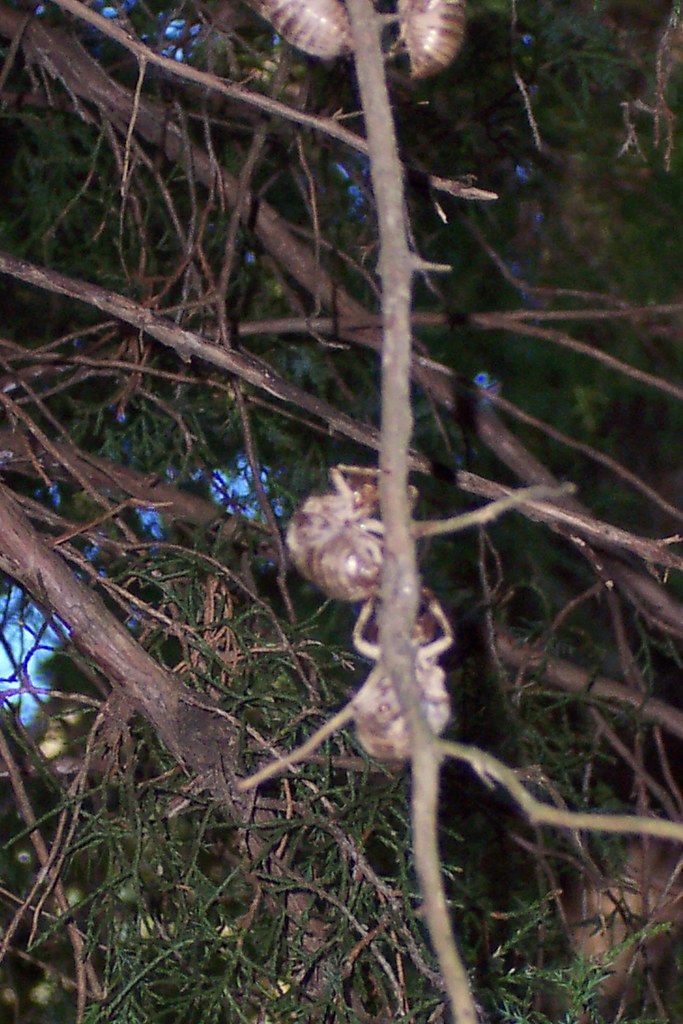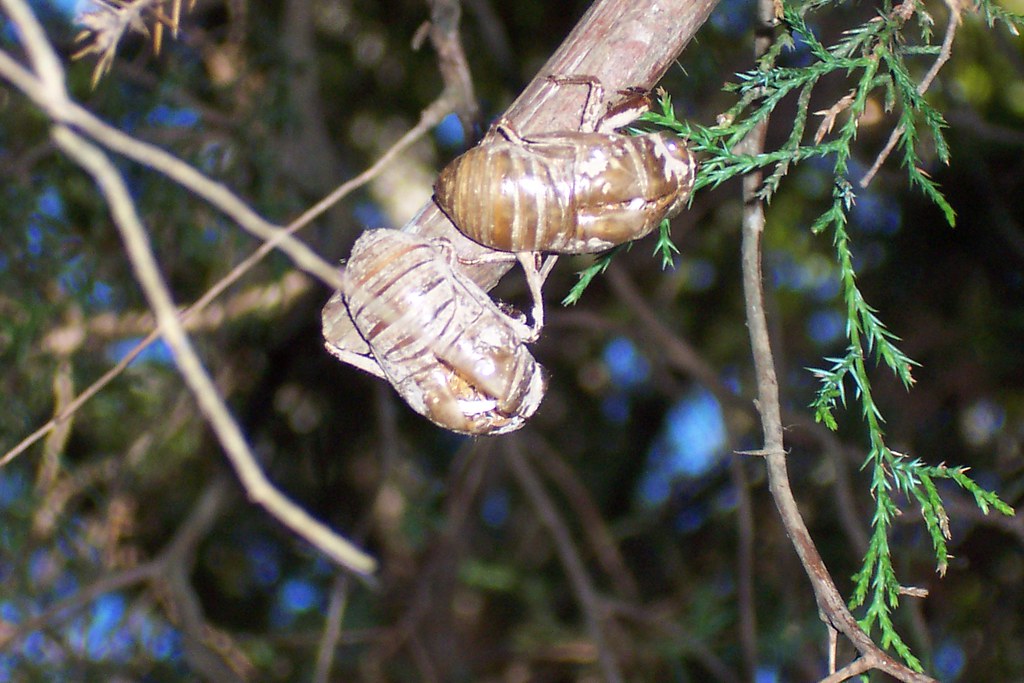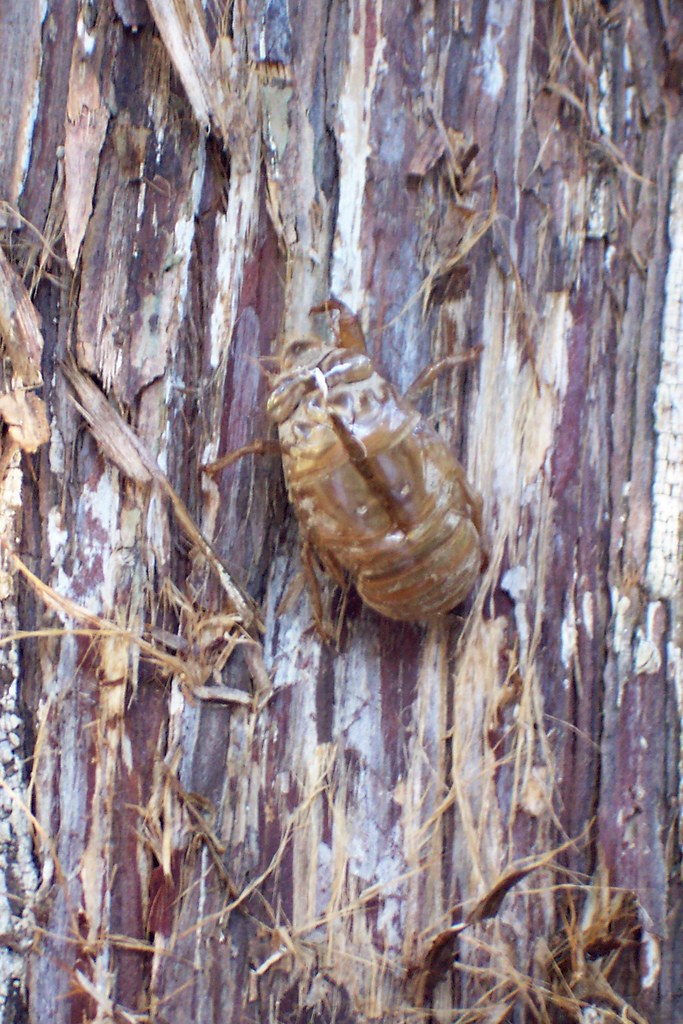
They come digging and clawing slowly as they make their way to the surface of the earth. They leave behind a dark and dreary hole in the ground that has been their home for a few months up to many years.

They climb up the cedar tree reaching for a branch where they can leave behind their useless shell and crawl out to become a flying machine in the southern summer sky.

The cedar tree provides a good footing for their prickly insect feet. It is a perfect foil under which many cicada eggs of all types were laid.

Some are able to crawl out of their shells by splitting the back and forcing the shell apart. Some tire before the task is done. All that is left behind are the shells of what used to be and holes in the ground; evidence of the deed....
in the garden....
This Eastern Red Cedar (Juniperus virginiana) was literally covered with cicada shells. The ground underneath was crunchy with all of the shells. Skeeter had it right when she said there were lots of cicadas this year. I have never seen so many in one spot in my garden. It really makes me wonder what goes on under the soil and makes me appreciate the cedar trees even more for the wildlife benefit they provide to the garden.
For an EXCELLENT series of photos showing a cicada emerging from its shell please see this link. It is a perfect series of photos showing the whole process.
Words and Photos Property of In the Garden Blog Team, In the Garden
I have seen quite a few shells around here too. Not like you have though.
ReplyDeleteI wonder if as much goes on under the ground as under the sea? Probably so. I have been noticing the skeletons showing up again around here. Nothing like back in spring though. Sad thing was with the Periodical Cicada, a lot of them had no where to climb once popping out. I found their skeletons all over the ground. But that did not stop them as they dried and flew off to sing their loud songs for us…
ReplyDeleteI have occasionally dug up some of the Cicada in the garden. They were solid white and in the pupa state. Since they were out of the ground, I put them in the bluebird feeder and they had a snack…
Oh, I forgot to mention in the pics of the Pond tours, I notice Mr. Fixit is becoming a rebel since retiring. His hair has never been so long to my eyes. Hee hee….
Have a great weekend. We hope to get to the lake if possible…
Good morning all. Tina that was a fascinating story. I've never seen those around here. But I do remember them when I was a kid & when in N.C. They can be quite noisy.
ReplyDeleteI hope all have a wonderful weekend.
The link is great. They are such a pretty color when coming out. One year when we were at your place they were out and busy but it was the first to middle of August so I am wondering if they are late this year of early the yea we were there. It is easy to remember when we were there as we were there for your graduation when you got your masters and graduation was on your birthday.
ReplyDeleteWe have a few, but you have an infestation! They have always fascinated me ever since I was a young girl. We had a lot of them back then, and I can remember wondering about the shells and the split back, and how/when/why/what would emerge.
ReplyDeleteDarla, There sure are a lot around here.
ReplyDeleteSkeeter, These ones here are most likely the yearly ones and not the periodical cicadas. We are a bit out of their range. Yup, that ole Rog is turning in to a hippie now I tell you. He promised me would when he retired. Ha.
Lola, Very noisy. You have a great weekend too.
Mom, Yes indeed they were out big time in August. They are still out but starting to slow down. Things are changing to fall here. They make their appearances between mid July-mid September or so. Very neat critters and I loved the link. Never seen the transformation happen before.
HolleyGarden, I find they are most fascinating too. Check that link as it sure shows the process well.
Everyone have a great weekend.
Those 13 year Cicadas were really in large numbers this summer....now it is the regular (annual) ones are singing and making their presence known. Remember as a kid gathering those shells? This year would be a bumper crop!
ReplyDeleteHi Tina, i didn't know cicadas are that plenty in the US, i thought they are tropical. We have lots of them too and very noisy in summer but not that much as yours. I just know they stay very long in the ground and live so shortly above the ground as adults. I see 3 kinds here, the bigger green ones become noisy at dusk, but those common greyish ones are alive during the hottest part of the day.
ReplyDeleteWhat a marvellous post this is. I have never seen anything like it, only the shells on trees, but never in such numbers. The series of photos you linked to are amazing. Insects are so alien and so fascinating.
ReplyDeleteYou know, I hear them in the trees every year. Once every 17 years we have the '17 Year Cicadas', but looking at them up close - not so much. (I'm a wuss...)
ReplyDeleteI do love the SOUND of cicadas, but a pile of crunchy shells is so gross! I love foxgloves too, and finally got some to seed for me. But they are so tiny, I hope they survive.
ReplyDeleteVery interesting, Tina. This is supposed to be the year of the 13-year cicadas in Illinois, which means we'll have hordes that appear only every 13 years. Or maybe it was 17 years? There was a lot written about them earlier this summer, and now I've forgotten how often they appear. At any rate, I'm not sure what happened to them, because I haven't noticed any more than usual this year.
ReplyDeleteHey Tina,
ReplyDeleteGlad to have uncovered your blog. I love its energy. This is the closest I've been to a cicada. I hate the way they interrupt a peaceful summer evening.
Thanks for sharing.